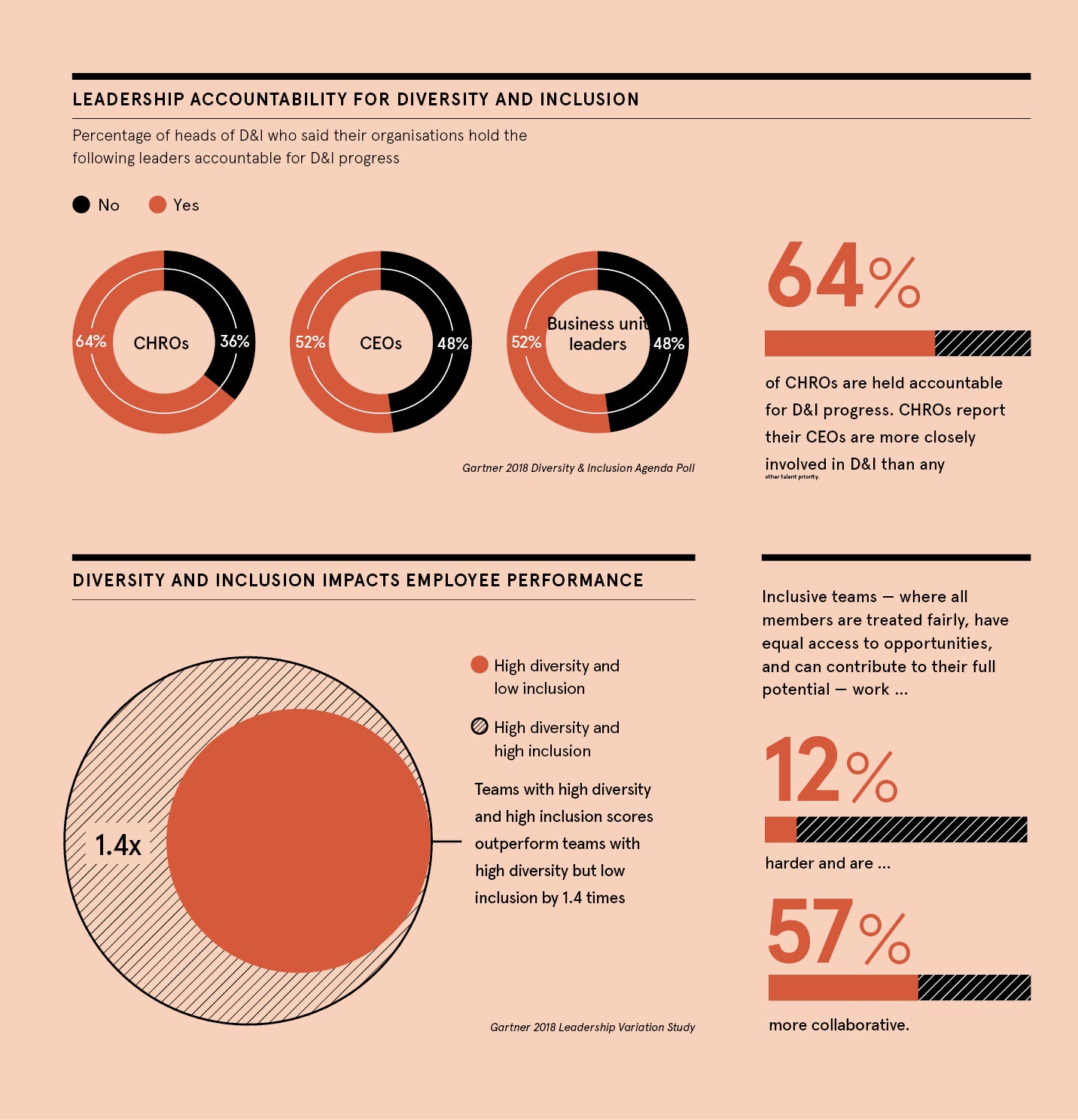Diversity and inclusion (D&I) is trending. Heads of talent recently surveyed by Gartner selected D&I as the chief executive’s number-one talent priority. While culture is the most cited talent management issue on earnings calls with investors, mentions of D&I have risen by 17 per cent since 2011 as executives increasingly recognise its close alignment with the overall success of a business.
“D&I is adjacent to so many business priorities,” says Lauren Romansky, managing vice president at Gartner Research & Advisory. “We already know that diverse and inclusive workforces drive employee productivity and retention.
“More broadly, cultures in which leaders and employees are tightly aligned in messaging, behaviour and processes can improve their performance by up to 9 per cent against revenue goals, up to 22 per cent against employee performance goals and up to 16 per cent against reputation outcomes.”
Leaders who are inclusive build inclusive teams and those teams clearly outperform all other teams
But inclusion is a discrete piece of the culture and performance puzzle that not every organisation tackles explicitly. And in the age of digitalisation, when innovation and collaboration are paramount, a lack of inclusivity will directly hurt business performance.
“CEOs want the best ideas and that means getting a diverse set of contributors, different opinions or points of view that challenge the mainstream,” says Ms Romansky.
Take Red Hat, the world’s leading provider of open-source enterprise solutions, including Linux, and well known as an innovative organisation. The company has built into its processes the expectation that all decisions will be made inclusively. The company believes, and Ms Romansky concurs based on Gartner research and client engagements, that decisions made with diverse input produce better outcomes than
those without it.
“Leaders who are inclusive build inclusive teams and those teams clearly outperform all other teams,” says Ms Romansky. “In fact, teams with high inclusion and high diversity even outperform teams with high diversity but low inclusion, by 1.4 times.”
So what should you do to be more inclusive or develop inclusivity in your leaders and teams? Ms Romansky offers a guide to the five things that inclusive leaders do differently.
Show integrity and settle conflict productively
These behaviours really differentiate the most consistently inclusive leaders, who are always fair
and productive both in their own behaviour and how they allow others in their team to interact with each other. They make clear you want to hear the truth about a situation no matter how inconvenient or unpleasant, and ensure task conflicts are resolved in ways that leave all team members feeling respected and heard. Inclusive leaders are able to leverage conflict productively to enhance team performance.
Create a safe space where people feel free to take risks
The goal is to create a setting where everyone is safe to take risks, voice their opinions and ask questions. To make this “psychological safety” routine, inclusive leaders consistently seek different perspectives, set up check-ins with team members from different backgrounds and ask about their perceptions of work and communication styles, and inclusion. To encourage participation, they leverage employee resource groups and partner with them on discussion around difficult D&I topics and current events.
Walk the talk and back it up with processes
As mentioned, culture is the backdrop to D&I. The most effective leaders not only act as role models through their words and personal actions, they also ask the critical question: “Do the processes and policies I am responsible for live the culture?” Let’s say an organisation is trying to drive a culture of collaboration and yet its people are constantly forced to say, “Great idea, but I don’t have that in my budget”. The siloed budgeting process is acting as a barrier to collaboration, probably inadvertently, but it is nevertheless sabotaging efforts to include a variety of stakeholders and opinions. Leaders own these processes and must take responsibility for removing process barriers to D&I goals.
Be accountable
Metrics are crucial to tracking progress against inclusion objectives, though they should be consistent with the organisation’s culture to ensure success is tied to performance goals. Inclusive leaders ask employees about mindsets, behaviours observed and outcomes they’re looking for. When possible, they also ask employees what they see, compared with what they do themselves. In our experience, this approach elicits more honest answers. Though it’s productive to partner with human resources to develop metrics and garner feedback, we’ve also seen leaders successfully captain their own surveys across business units.
Broker network connections
Leaders can’t be all things to all employees. Their team members may be looking for mentorship or support, especially if they’re under-represented at the organisation or see themselves as an outlier in any way. Inclusive organisations use their networks to broker meaningful connections for employees and support their participation in firm initiatives, such as business-aligned employee resource groups. If done well, these groups can drive inclusion and empower employees.
How inclusive is your team?
Download your self-assessment to find out and get exclusive access to our latest content on D&I. Hear from our leading speaker Lee-Anne Vallée, director of HR advisory at Gartner, to learn how you can eliminate bias within processes to ensure equitable hiring, pay, reviews and assignment of promotable work.
Get your inclusivity assessment and watch on demand at: gtnr.it/d-i
For more information please contact [email protected]






